Islak Burgers: the Wet Sliders of Istanbul
The Islak hamburger is a Turkish street food that most accounts say was invented at a Taksim Square establishment called Kristal Bufe sometime in the 1960s or 1970s. Islak is a Turkish word meaning “wet,” and these “wet burgers” are just that, soaked inside and out with a garlicky tomato sauce before sitting in a steam cabinet awaiting purchase. Taksim Square is a neighborhood on the European side of the Bosphorus Strait, often described as the heart of modern Istanbul, a bustling hub of transit, shopping, tourism, food, and nightlife. Islak burgers are widely praised, even by their detractors, as the ultimate drunken snack. No stranger to drunken snacking, patron saint of street food Anthony Bourdain tried one in a brief segment of a 2009 No Reservations episode (starting around the 12:30 mark in the below video). He remarked, “Ooh! It’s like a big, spicy slider!”
My friend and coworker Deniz, a native of Istanbul, is not privy to the full colorful history of the Islak burger. “I had never heard of them before they blew up around 2011/2012,” she told me. But she does remember them surging in popularity a decade ago. “I remember that they became famous when I was in high school, when a chain called Kizilkayalar started serving them. People were obsessed with them and would form lines in front of this store,” she said.
Unlike my friends Daniel and Katy who tried an Islak burger at Kizilkayalar in Taksim Square about a year ago, I wasn’t going to be able to travel there myself and have one in person. In a stroke of good timing though, Deniz had planned a trip to Istanbul to visit family this month, and was able to provide me a first-hand account of the Islak burger in its native environs, photos of the Kizilkayalar location she visited, and of the burger itself.



“The whole taste is very… simple? With just the bread and meat patty burger made inside the red tomato sauce. Compared to a burger with toppings like cheese, lettuce, etc., it’s almost like the bread version of an Italian meatball starter.”



“The bread is super soft and soggy. Both the bread and the meat patty are quite thin; the burger is quite small and not overwhelming. My understanding is that a man of average size orders 2-3 of these to eat for a meal. The seasoning overall tastes [heavily of] black pepper.”
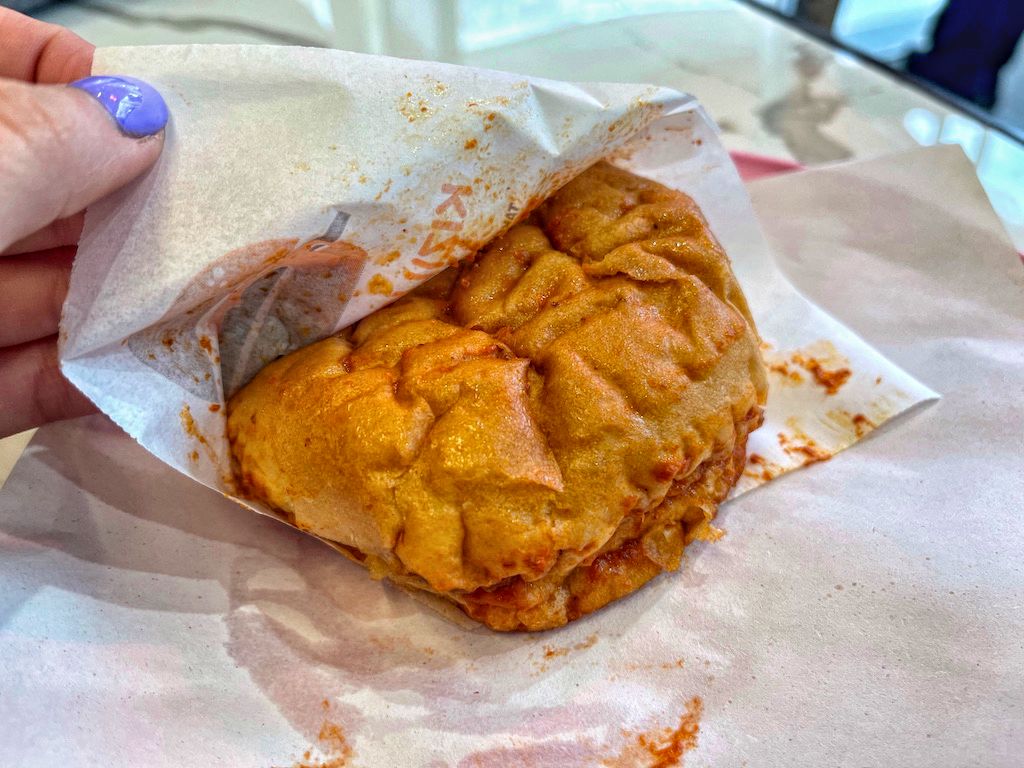
Some of the recipes I’d been looking at for my own attempt at an Islak burger seemed more meatball-like, with onion, garlic, spices, even bread crumbs adulterating the ground beef of the burger patty. I asked Deniz whether that seemed to be the case, and got an authoritative answer.
“My mom wanted me to tell you that she thinks there [were] no bread crumbs in the version we ate but definitely onions, garlic, cumin, salt and a ton of black pepper.”
I know Deniz knows good food and I trust her palate. That knowledge didn’t come from a vacuum. If Deniz’s mom says there were no breadcrumbs in the patty, I believe her.
Then I read another comment online that helped make things come together in my head. “I’m happy to report that the meat inside is döner meat and not a cheap, processed circle of nastiness.”
Yes, that is a terrible no-good very bad comment, maligning the noble name of the classic hamburger while simultaneously proposing something clearly false–that the meat in an Islak burger is actually doner kebab meat. I don’t think this meat was cut from a cone on a vertical spit. But perhaps the meat is seasoned very much like the meat from a doner kebab.
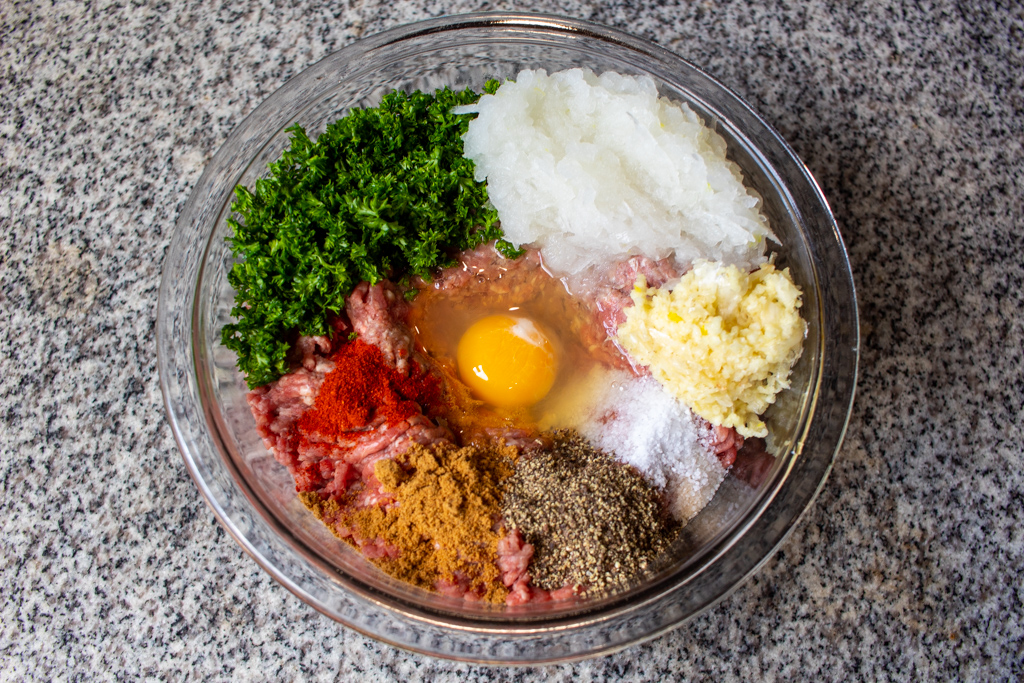
So I mixed about 1.75lb of ground chuck (80%/20% fat/lean ratio) with a handful of chopped parsley; half a good-sized onion, grated; 5 large cloves of garlic, minced; a teaspoon of kosher salt; 1.5 – 2 teaspoons of freshly-milled black pepper; 1 tsp cumin powder; 1/2 tsp hot Hungarian paprika; and an egg. This combined into a seasoned beef mixture not unlike the makeup of a doner kebab cone, but with a heavier dose of black pepper, as described by Deniz and her mother.
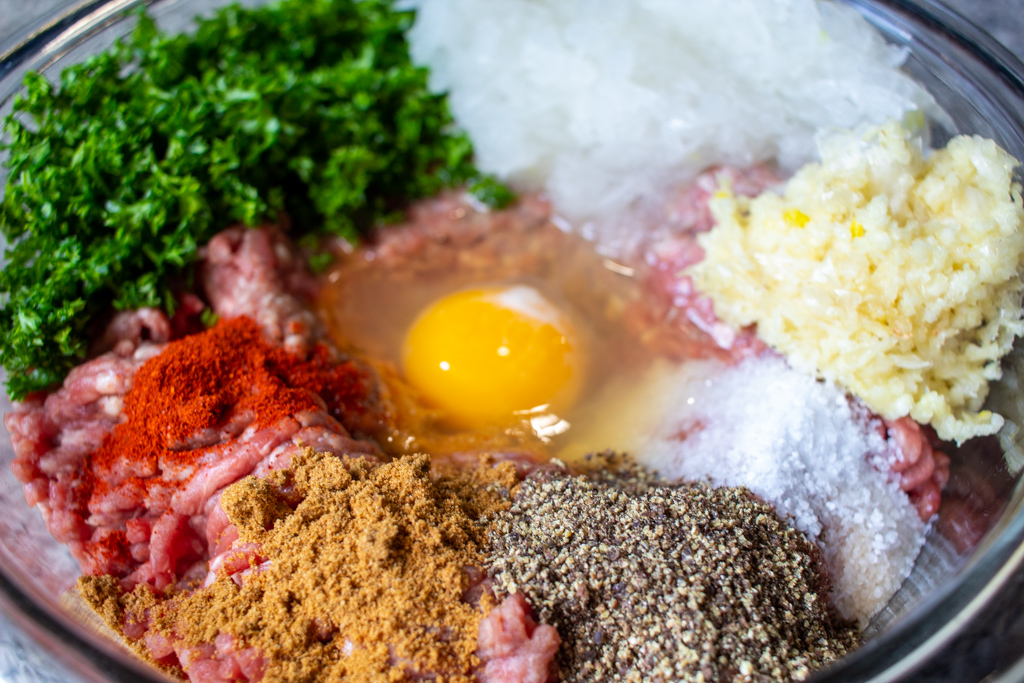
Some sandwiches are less photogenic than others. The Islak burger is one of them. This may be the last good photo you’ll see this article. Pause a moment. Savor it.
….OK. Moving on
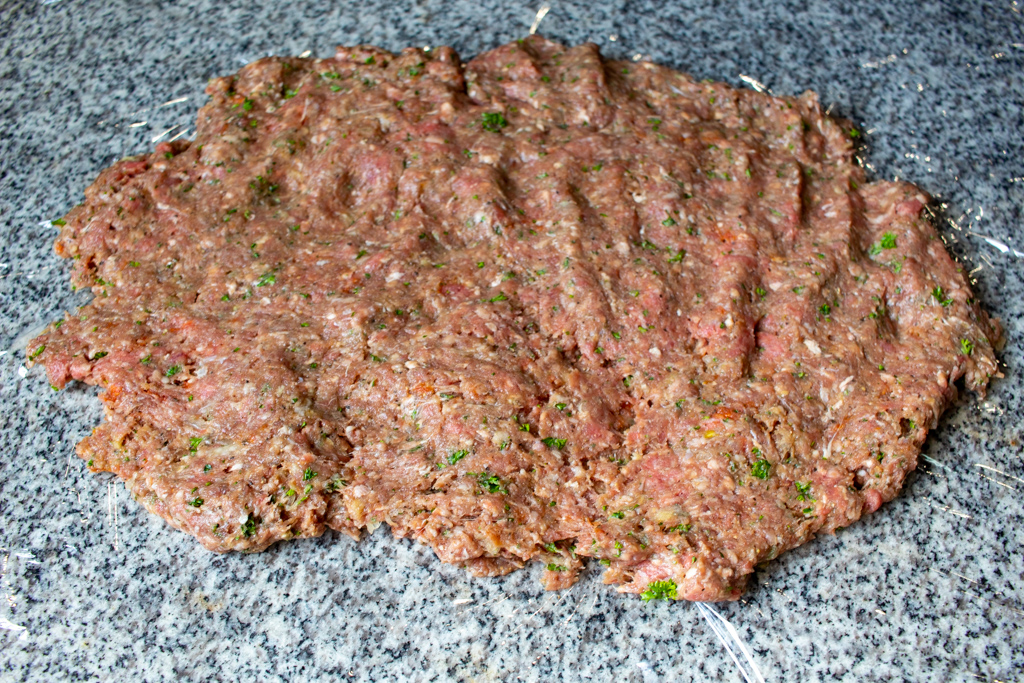
To make the beef into patties, I covered it top and bottom with plastic wrap and rolled it out to an even thickness with a rolling pin.

Then I used my largest biscuit cutter to cut the meat into rough circles approximating the diameter of a standard hamburger bun.

The “wet” part of wet burger comes mainly from the sauce that is the sole condiment of an Islak burger. The sauce is a fairly simple tomato sauce, spicy from the plentiful addition of black pepper and garlic and very slightly sweet from the little bit of ketchup that went into it.

The sauce gets added to the insides of both the top and bottom buns, soaking into the bread, before the meat is placed inside.

Speaking of the meat…
A note on process: everything I know about cooking an Islak burger I learned by watching this Youtube video. Fair warning: I did not watch it all the way through. They’re speaking what I presume to be Turkish, which I do not understand, and so I skipped a lot of the talky bits. But I got the gist of it. It appears that the patties are rolled out very flat and thin and cut to the exact size of the bun, as I did. It also appears that they cook the raw patties right on top of the buns in a sandwich press.
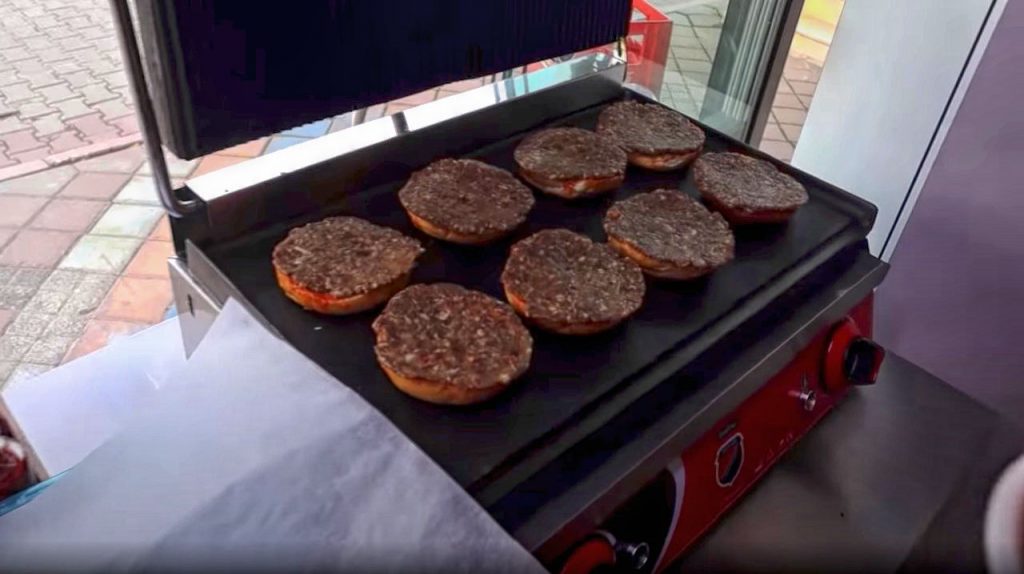
The cook in this video places a sheet of wax paper atop the patties, perhaps to keep them from sticking to the top grill of the press, or perhaps just for neatness’ sake. He then closes the press and pushes evenly down on the top to ensure full contact between the raw meat and the hot grill.
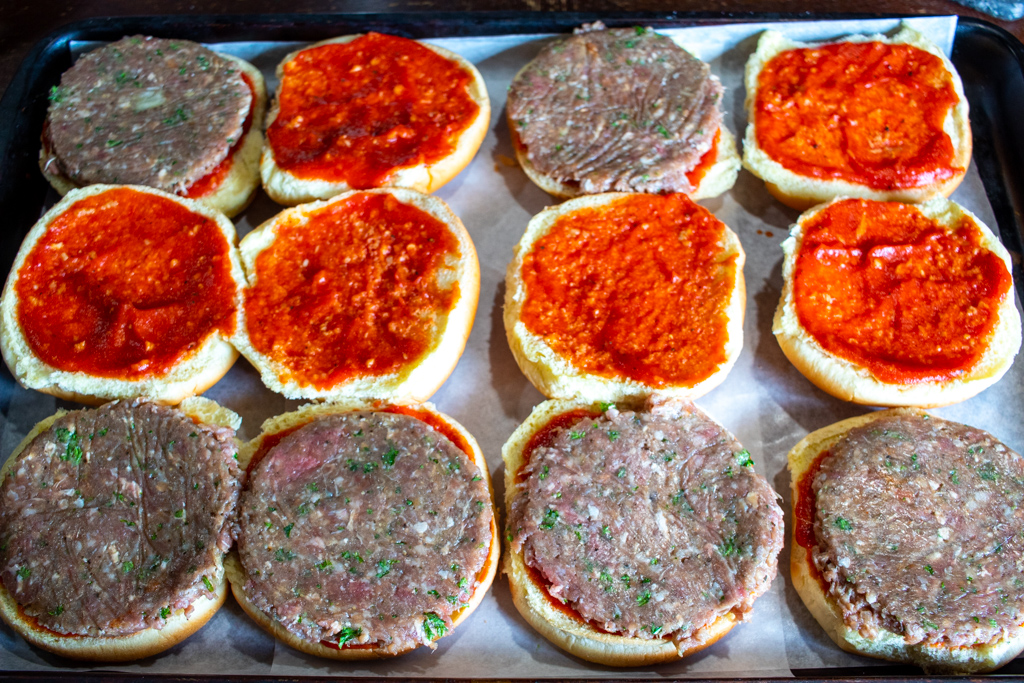
Cross-contamination concerns tell me that putting the raw meat directly into contact with the hamburger bun is a bad idea. However, logic also tells me that as long as the meat gets cooked thoroughly, and given that the buns and meat and all will be placed into a steamer afterwards, that this should not present a food safety issue. I don’t think it’d pass muster with local health departments–I don’t know for sure, maybe someone can enlighten me?–but it should be fine for a one-off home-cooked burger. Besides, we’ve eaten Cannibal Sandwiches here at the Tribunal. So I put the raw meat on the buns.
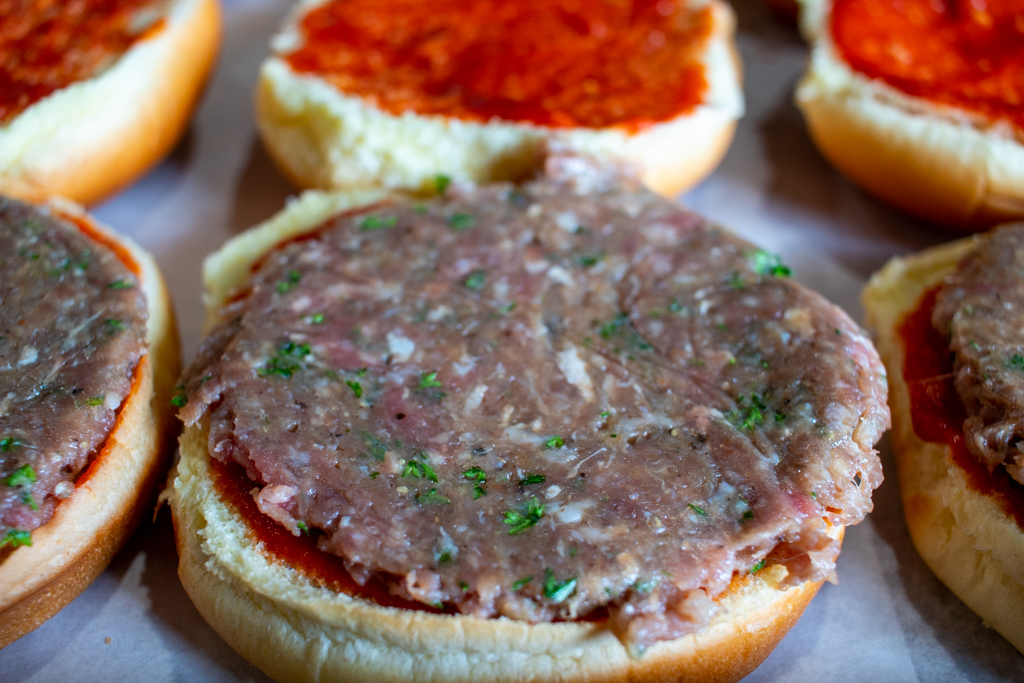
Now before the bottom buns with the meat on them are place into the sandwich press, the outsides of the buns get soaked with that tomato sauce as well.
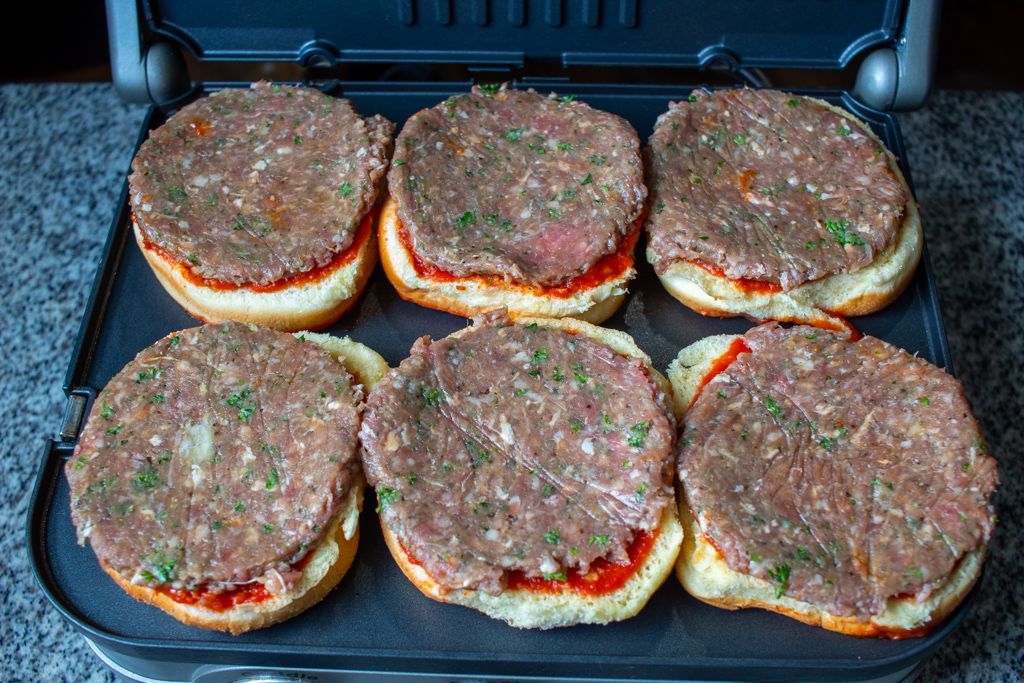
I cooked these at a medium-high temperature for several minutes before opening the press and turning the patties over. The meat rendered quite a bit of fat while it cooked and shrunk noticeably as a result.

If we were using breadcrumbs, those would absorb the fat and the patties would likely not shrink as much. I suppose that is the advantage of cooking them right on the buns though–the bun then absorbs that rendered fat, keeping its flavor in the sandwich.

Another note on the Youtube video. This cook kept a couple of different types of cheese next to his sandwich press, and used them on some of the burgers he was making. There were squares of yellow and white cheese, stacked in that perfect way that bespeaks machines and processing and a waxy store-bought American type of cheese.
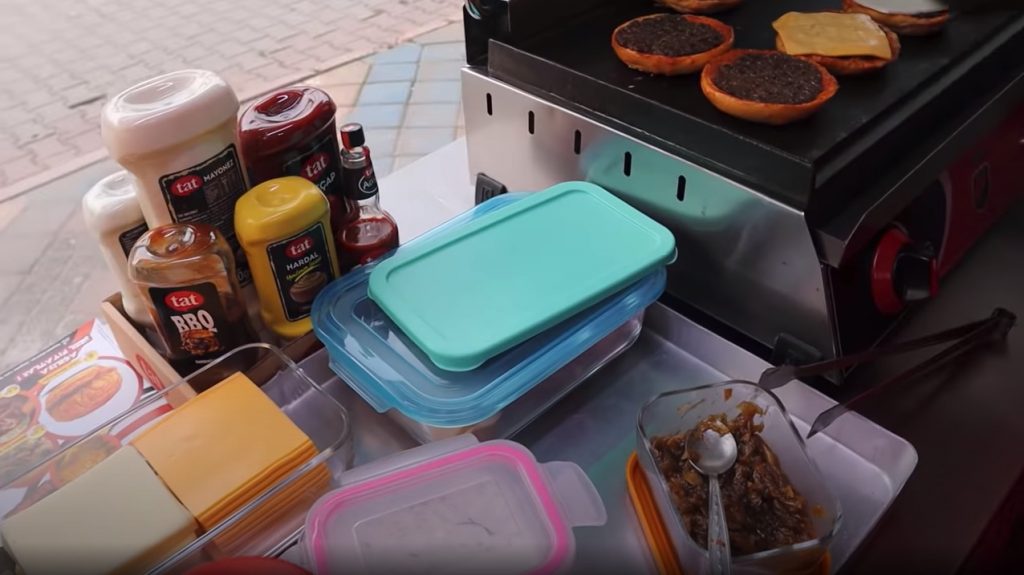
I asked Deniz about cheese options on the burgers and she said that yes, they did have a cheeseburger version with just cheese added. “I didn’t try it but my friends said they always get that cheeseburger version.” I asked if she thought it might be a processed cheese, something like an American cheese, whatever that might be called in Turkey. “My guess is the cheese was Kasar. It’s the go-to cheese here for melting.”
Google and/or Wikipedia tell me that Kasar cheese is the same as or similar to Kasseri cheese, which in turn is the same as or similar to Kashkaval cheese, which is something I can actually find at a nearby Mediterranean market. Who knows how far off the mark these degrees of separation have landed me from actual Kasar, but this is good cheese.

Still, in that photo up above–I can’t shake the thought that the yellow stuff looks an awful lot like American cheese. What’s it going to hurt to try it?
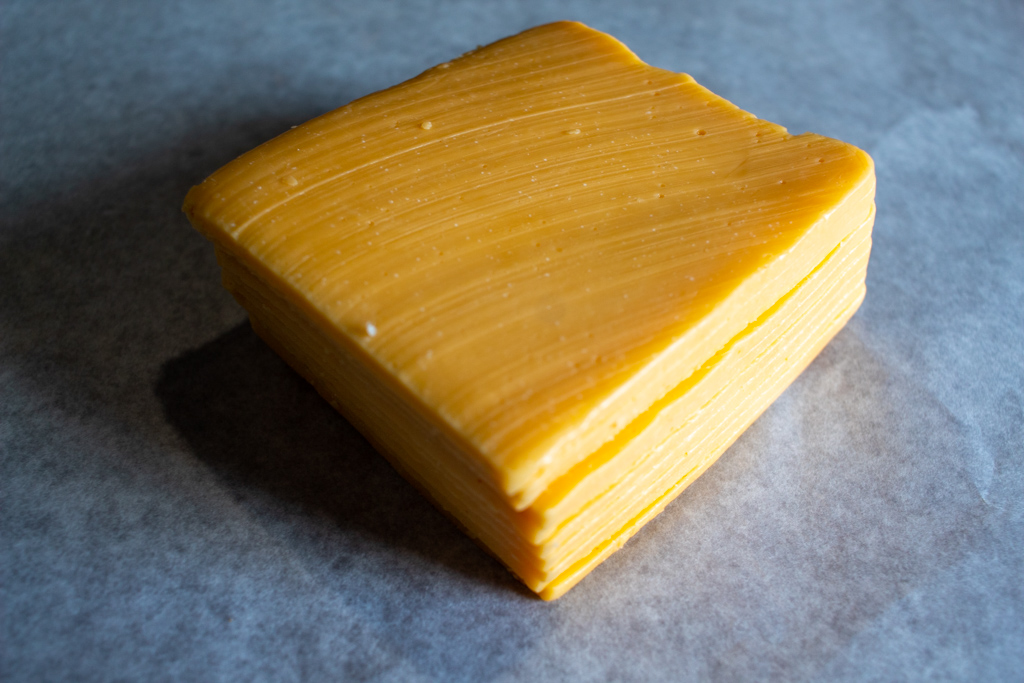
I can fit 6 of these burgers on my sandwich press at one time. I put Kashkaval cheese on two of them, and the yellow American cheese on two, leaving the final two cheeseless.
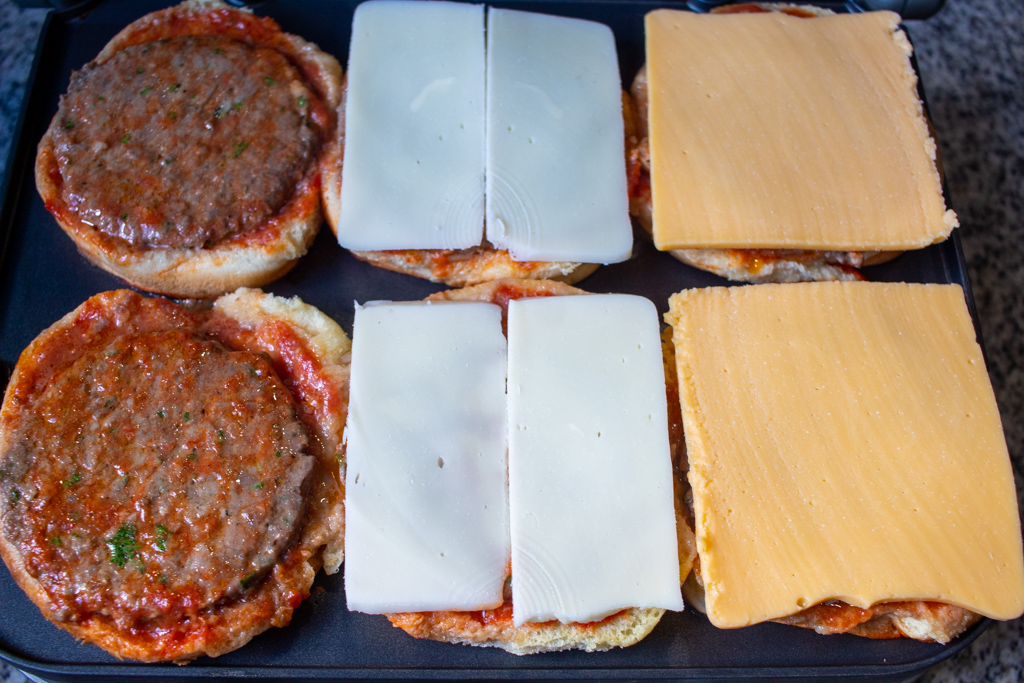
Now the top bun also gets its outside coated in tomato sauce, and the finished burgers are put in a steam cabinet until they’re ready to be eaten. I used my large tamale steamer and gave them 10 minutes. (PROTIP: 10 minutes was too long and/or my steamer was going too hard)
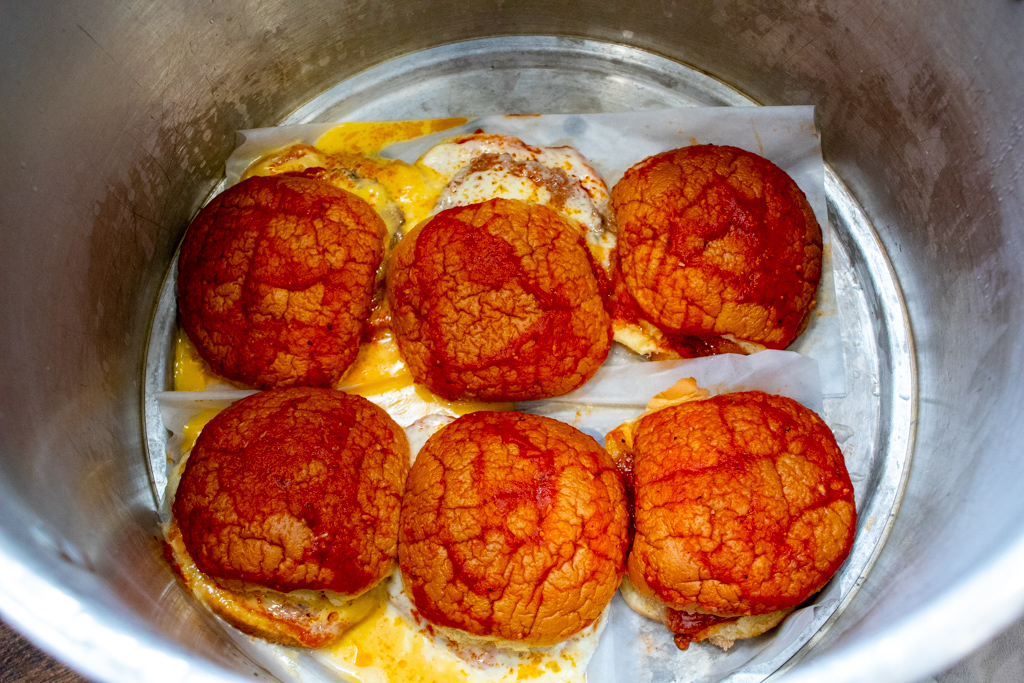
After 10 minutes in the steamer, the cheese had largely freed itself from the confines of the burger bun, spreading out onto the wax paper below and taking the top bun and even the patty on a journey as well. Removing the burgers safely from the hot steamer pan wasn’t easy either–note to self, the little plastic electric steamers may be worth it.
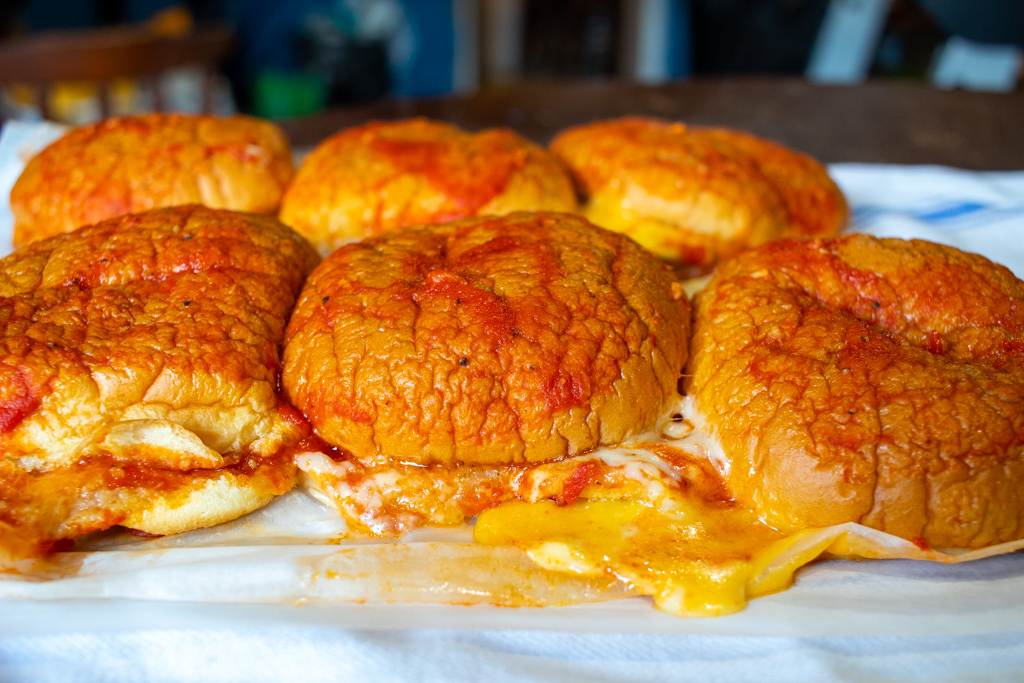
After 10 minutes in the steamer, the buns had softened considerably, and pruned up like your fingers in a bath. The pooling cheese adhered the soft, fragile buns to their wax paper liners, making burger retrieval a very careful business. However, with the help of a plastic spatula and more patience than I’m often able to summon, I was able to separate them and get them into individual wax paper wrappers.

As I mentioned, these are not photogenic sandwiches

Deniz agrees, but also says that this particular photo looks just like what she had in Istanbul. Success!
I cut each of the burgers in half to try to get a cross-section, but the differences in appearance were minimal.



Of the three, I liked the simplicity of the cheeseless version the best. The overall impression of the burger is a soft texture and a rich, garlicky tomato flavor heavily accented by the prickly black pepper heat lying like an electric blanket across the tongue. Of the cheeses, the Kashkaval works better with the burger, its mild cheddar-like flavor not overwhelming the very small thin patty. However, the American cheese just doesn’t belong. Its brash salty flavor and waxy melting texture are a perfect match for most burgers but clash with the strong garlic and tomato flavors here.
Experimenting further, I tried actually cooking the burger inside the bun, in the steamer. Since this involved leaving it in there for twice as long, the result was even soggier than the standard wet burger. The bun deflated almost completely, sodden with tomato sauce and meat juices and condensed steam.
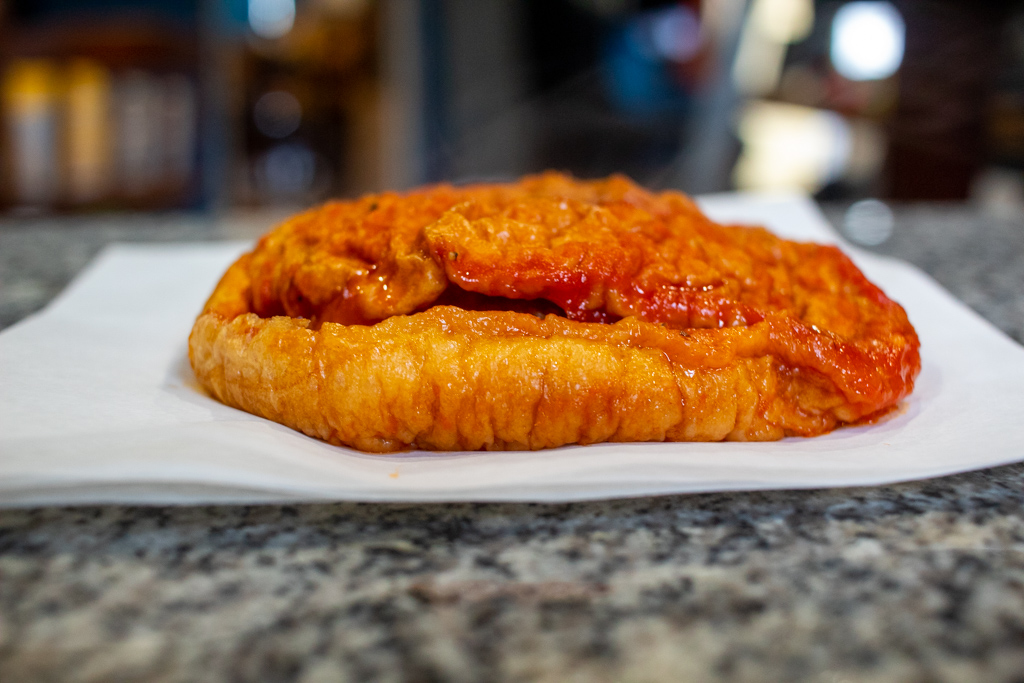
Clearly, less time in the steamer is needed, as well as a gentler heat. Additionally, this was a brioche bun, larger and sturdier than the simple burger buns I’d used previously. After a steam bath, it doesn’t matter what kind of bun I used; you’d better like that soft bread if you’re going to eat a steamed sandwich. And the concept of a sandwich with soggy bread isn’t unfamiliar to a person who’s eaten as many dipped Italian Beef sandwiches as I have. But this one was just too far gone.
So I made them one more time. I made my patties ever so slightly thicker and wider, to combat the shrinking that occurs during cooking. I cooked them in the sandwich press again, atop the sauce-soaked bun. I made two with regular hamburger buns and two with brioche. Two with Kashkaval cheese, two without. And when the patties were cooked and the burgers assembled, they went into a steamer set to a more gentle heat, for no more than 2-3 minutes.
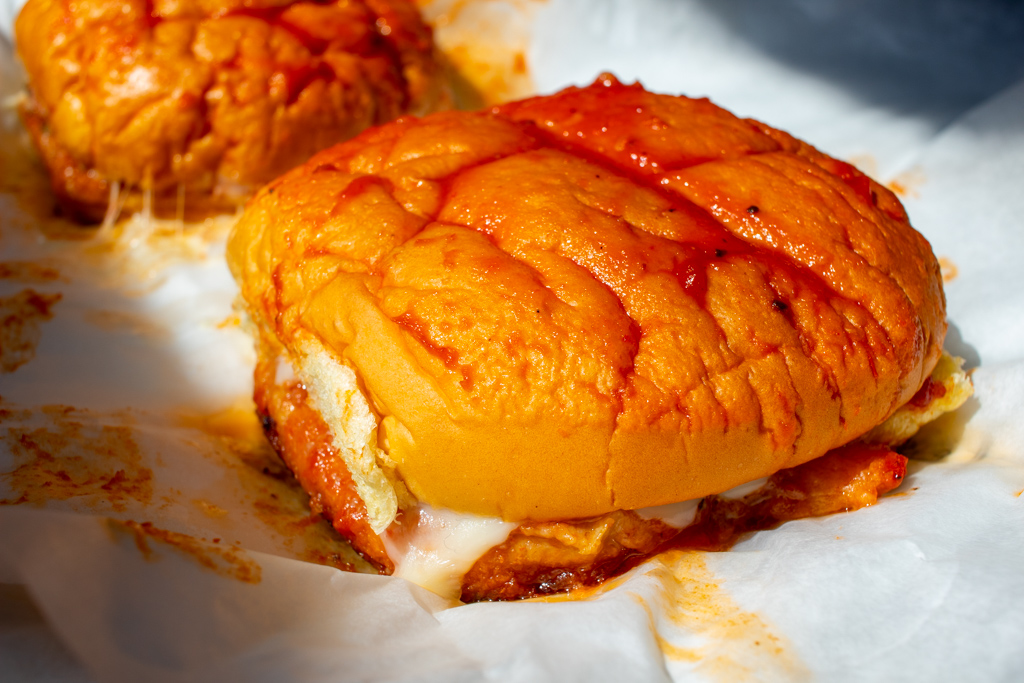
It’s still difficult to tell which is the regular bun and which the brioche. I believe the regular bun is in the foreground here based solely on the section of bun that appears as if it’s been ripped from its neighbors in a package of cheap grocery-store hamburger buns. The brioche buns were not stuck together in this way.
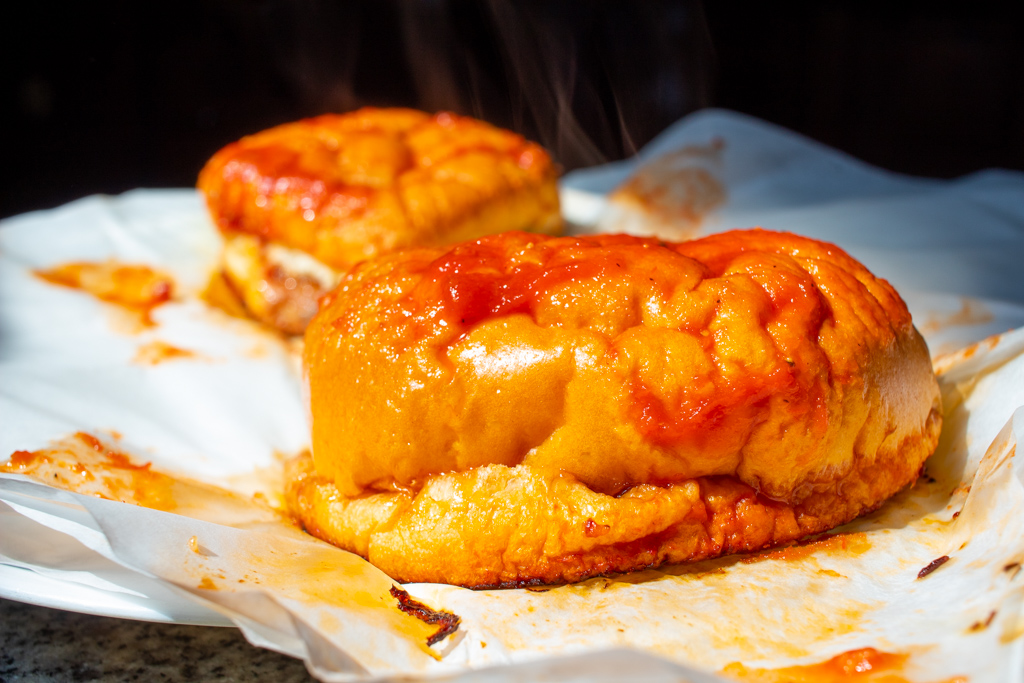
The differences in buns are not evident though, unless you are the person who made these sandwiches. I had the heat slightly higher on the sandwich press this time, to try to cook the slightly thicker burgers thoroughly, and the bun bottoms got a little caramelized as a result. Not unpleasantly so, but noticeably. These burgers may be perfect for a night of drinking, but they make a fine lunch as well.


And I wasn’t likely to improve upon this iteration of my Islak burgers. I understand why some people find these sandwiches offputting–texturally they are soft and one-note; they are a mess to eat; and as noted, they are most likely best appreciated after a night spent drinking raki with friends in Istanbul. Context is important, and it is unlikely that we will begin seeing Islak burger stands popping up around Rush Street or Wrigleyville anytime soon. Don’t be too surprised if they do though–the Germans brought Turkish doner kebab to the world, and based on the number of German language videos on Youtube for “Nasser” (German for wet) burgers, they’re catching on to this treat as well.
If the Islak burger ever does make it to our shores, I’ll be sure to get one. Until then, I have more sandwiches to explore. See you in April!

I like sandwiches.
I like a lot of other things too but sandwiches are pretty great




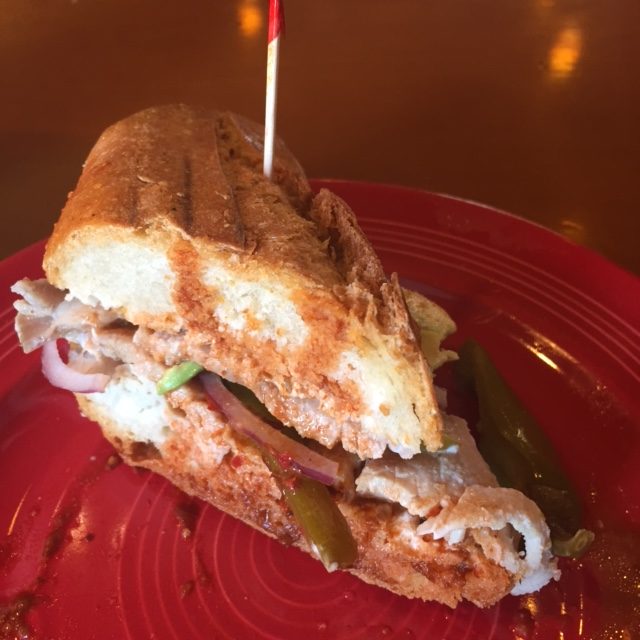






Recent Comments